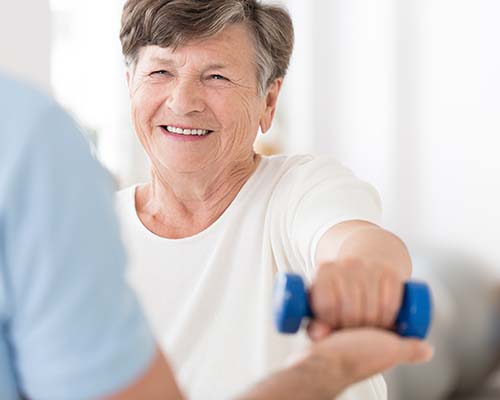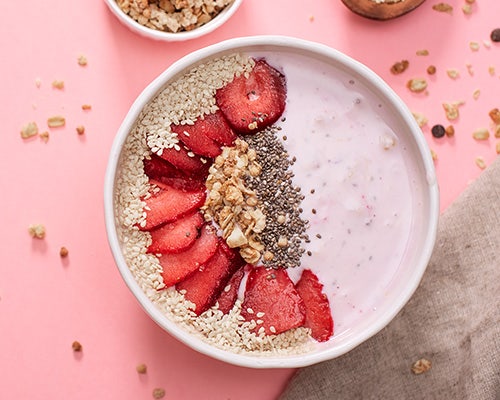Osteoporosis: The Silent Threat to Bone Health
- 12/18/18

by Ashley Grano
The old saying “drink your milk” that parents told their children for strong bones still holds true – bone health really does begin in childhood, according to The National Institutes of Health (NIH). Since most milk is fortified with vitamin D, which helps the body absorb calcium, milk really can help promote healthy bones during the growth and developmental years, according to the NIH. However, there are still ways to help keep bones as healthy as possible throughout adulthood. Further, the good news is that many of the ways that promote bone health are also beneficial for overall well-being.
Understanding bone health
Bone mass, aka bone density, is how bone strength (and subsequently, bone health) is ultimately measured. In youth, bone mass naturally increases, according to the Mayo Clinic. After age 30, bone mass begins to decline. However, the rate for this decline is highly variable for each person. Physical activity, diet, lifestyle, and other factors can all influence bone mass and the rate of loss. Maintaining a greater bone mass means a lesser risk of developing osteoporosis, the condition known for causing bones to become weak and brittle, says the Mayo Clinic.
Recognizing early signs of bone loss is also critical, and an important first step in maintaining bone health. A bone density test is painless and is one of the best ways to evaluate current health status and monitor loss going forward. According to The National Institutes of Health, women over 50 are at a higher risk for osteoporosis and compromised bone health due to hormonal production decline around menopause. However, men too are at risk, and should also start implementing (or continuing) healthy habits that can help maintain bone mass.
The National Osteoporosis Foundation estimates that 54 million Americans have low bone density or osteoporosis. It is a common misperception that there are always signs of weakening bones. The NOF says that osteoporosis is an often “silent” disease. As a result, many people don’t begin caring for bone health until after they’ve endured a fracture or broken bone, such as after a fall. These bone fractures, especially those in the spine or hip, can be very serious and lead to disability or even risk of death, says the Mayo Clinic.
Risk factors for bone loss
Unfortunately, not all risk factors for osteoporosis are preventable. Some uncontrollable risk factors include gender (women at a higher risk), advanced age, race (Whites and Asians at higher risk), genetics, and body frame size (smaller at a higher risk), according to the Mayo Clinic. Lowered sex hormones and thyroid issues can also lead to lower bone density. People with certain conditions such as Celiac disease, inflammatory bowel disease, kidney or liver disease, cancer, Lupus, and Rheumatoid arthritis, are also at a higher risk for bone loss.
Fortunately, many other factors are controllable, although they can be difficult to change. These habits include smoking, excessive alcohol intake (more than 2 drinks daily), and not getting enough physical activity.
How to help promote healthy bones and mitigate bone loss
While the bulk of bone density may be gained in childhood and throughout youth, starting to practice healthy bone habits benefits any age and lowers the risk of developing issues, says the National Osteoporosis Foundation.
Engaging in regular physical activity is one of the most important things to do for maintaining bone health, according to the National Osteoporosis Foundation. Adults should aim for a minimum of 30 minutes of exercise daily, incorporating both weight-bearing and muscle-strengthening exercises. This can include activities like walking, jogging, tennis, and climbing stairs, in addition to activities like lifting weights, gardening, or using resistance bands. Also be sure to mix in activities that help improve balance, like yoga, dancing, and Tai Chi.
Eating a diet rich in both calcium and vitamin D is also very important. Some guidelines from the Mayo Clinic suggests taking:
Healthy options for calcium-rich foods includes dairy products like milk, cheese, and yogurt, as well as almonds, broccoli, kale, salmon, and sardines. For vitamin D, opt for oily fish like tuna, as well as egg yolks, and fortified milk. 10 minutes of direct sunlight a day also boosts the body’s natural production of vitamin D. Supplementation of both calcium and vitamin D may be necessary.
The old saying “drink your milk” that parents told their children for strong bones still holds true – bone health really does begin in childhood, according to The National Institutes of Health (NIH). Since most milk is fortified with vitamin D, which helps the body absorb calcium, milk really can help promote healthy bones during the growth and developmental years, according to the NIH. However, there are still ways to help keep bones as healthy as possible throughout adulthood. Further, the good news is that many of the ways that promote bone health are also beneficial for overall well-being.
Understanding bone health
Bone mass, aka bone density, is how bone strength (and subsequently, bone health) is ultimately measured. In youth, bone mass naturally increases, according to the Mayo Clinic. After age 30, bone mass begins to decline. However, the rate for this decline is highly variable for each person. Physical activity, diet, lifestyle, and other factors can all influence bone mass and the rate of loss. Maintaining a greater bone mass means a lesser risk of developing osteoporosis, the condition known for causing bones to become weak and brittle, says the Mayo Clinic.
Recognizing early signs of bone loss is also critical, and an important first step in maintaining bone health. A bone density test is painless and is one of the best ways to evaluate current health status and monitor loss going forward. According to The National Institutes of Health, women over 50 are at a higher risk for osteoporosis and compromised bone health due to hormonal production decline around menopause. However, men too are at risk, and should also start implementing (or continuing) healthy habits that can help maintain bone mass.
The National Osteoporosis Foundation estimates that 54 million Americans have low bone density or osteoporosis. It is a common misperception that there are always signs of weakening bones. The NOF says that osteoporosis is an often “silent” disease. As a result, many people don’t begin caring for bone health until after they’ve endured a fracture or broken bone, such as after a fall. These bone fractures, especially those in the spine or hip, can be very serious and lead to disability or even risk of death, says the Mayo Clinic.
Risk factors for bone loss
Unfortunately, not all risk factors for osteoporosis are preventable. Some uncontrollable risk factors include gender (women at a higher risk), advanced age, race (Whites and Asians at higher risk), genetics, and body frame size (smaller at a higher risk), according to the Mayo Clinic. Lowered sex hormones and thyroid issues can also lead to lower bone density. People with certain conditions such as Celiac disease, inflammatory bowel disease, kidney or liver disease, cancer, Lupus, and Rheumatoid arthritis, are also at a higher risk for bone loss.
Fortunately, many other factors are controllable, although they can be difficult to change. These habits include smoking, excessive alcohol intake (more than 2 drinks daily), and not getting enough physical activity.
How to help promote healthy bones and mitigate bone loss
While the bulk of bone density may be gained in childhood and throughout youth, starting to practice healthy bone habits benefits any age and lowers the risk of developing issues, says the National Osteoporosis Foundation.
Engaging in regular physical activity is one of the most important things to do for maintaining bone health, according to the National Osteoporosis Foundation. Adults should aim for a minimum of 30 minutes of exercise daily, incorporating both weight-bearing and muscle-strengthening exercises. This can include activities like walking, jogging, tennis, and climbing stairs, in addition to activities like lifting weights, gardening, or using resistance bands. Also be sure to mix in activities that help improve balance, like yoga, dancing, and Tai Chi.
Eating a diet rich in both calcium and vitamin D is also very important. Some guidelines from the Mayo Clinic suggests taking:
- 1,000 mg of calcium daily: women 19-50, and men 51-70
- 1,200 mg of calcium daily: women 50+ and men 70+
- 600 international units (IUs) of vitamin D daily: adults 19-70
- 800 IUs of vitamin D daily: adults 71+
Healthy options for calcium-rich foods includes dairy products like milk, cheese, and yogurt, as well as almonds, broccoli, kale, salmon, and sardines. For vitamin D, opt for oily fish like tuna, as well as egg yolks, and fortified milk. 10 minutes of direct sunlight a day also boosts the body’s natural production of vitamin D. Supplementation of both calcium and vitamin D may be necessary.





